|
How modern electrical recordings are made.
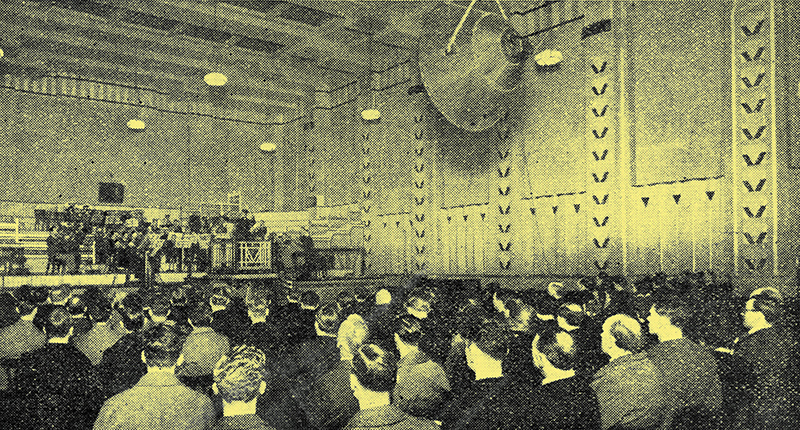
General view of the No. 1 studio for recording choral and orchestra! works.
In November, I931, the whole of the recording organisation of the Gramophone Company was transferred from Hayes, Middlesex, to St. John's Wood, London, NW (Abbey Road). The move was made primarily in the interests of the recording artistes, who can now fit in a recording session more conveniently with their London concert engagements; but the technical staff were quick to seize the opportunities presented to them, and the new building is probably unique inasmuch as it is designed throughout for the exclusive purpose of gramophone recording.
All the studios have been acoustically designed for the special requirements of recording, and the temperature of the building as a whole is kept at a level suitable for the wax discs. The warning lights outside studios create an atmosphere reminiscent of Broadcasting House, and this impression is strengthened when it is discovered that a special department is devoted to the cataloguing and storing of music.
There are four studios ranging from the No. 1 orchestral studio, capable of accommodating two hundred performers on the stage and seven hundred on the floor, to the small talks studio. The acoustic properties of the large studio can be modified for different types of performance by movable screening partitions and damping curtains. It is possible to use as many as four microphones simultaneously, and there is a parabolic reflector which may be used to obtain the required balance in special circumstances.
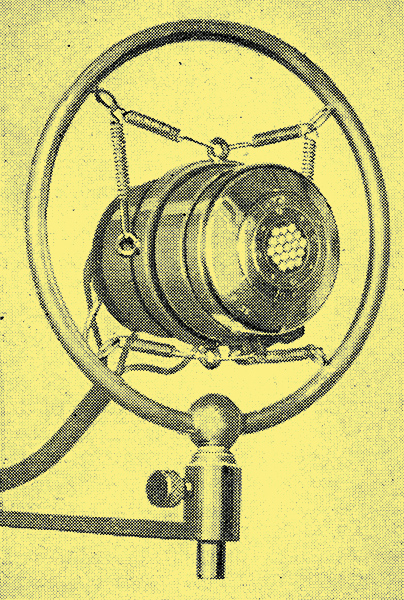
The moving-coil microphone.
The microphones are of the moving-coil type, and have been designed and developed by the Gramophone Company. They are energised from accumulators, and the field strength is adjusted to a pre-determined value as it exercises some control over the frequency characteristic. It is interesting to note that the miniature diaphragm attached to the moving coil is of Balsa wood.
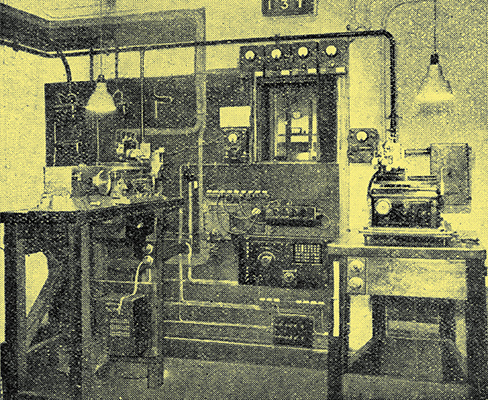
Interior of one of the machine rooms, showing twin recorders and double window communicating with the studio.
Each studio has its own recording room, and the recording engineer is able to communicate with the studio staff through a small double window. In the general-view of one of the recording rooms will be seen the four small control panels and meters immediately above the window which supply the field current to the microphones. The two similar panels at the lower corners are for the moving-coil recorders. Immediately below the window are the mixing and fading controls for the microphones, a system of tone correction filters, and the main volume control which is calibrated in decibels.
The recorder turntables are driven by gravity weights, and governors of special design are employed to keep the speed constant. The recorder head is fixed, and the turntable is gradually moved sideways by the lead screw. The recorder head works on the moving-coil principle, and the speech coils are fixed on the pole pieces of a powerful electro-magnet. The drive is transmitted to the cutting stylus by a single-turn coil which is closely coupled magnetically to the speech coils. The unit as a whole is carefully counter-balanced, and a micrometer feed is provided to vary the depth of the cut. An air suction tube immediately behind the stylus removes all traces of wax shavings from the surface of the record. Although it is not often necessary, an immediate play-back may be taken from the wax by a specially designed pick-up mounted on the opposite side of the swivel head.
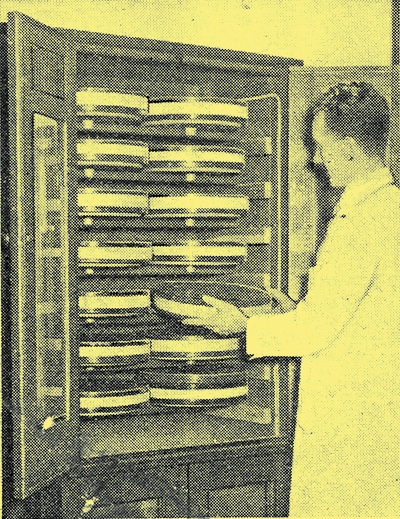
The recording waxes are stored in a temperature-controlled cupboard.
Wax blanks are stored in a thermostatically-controlled heating cupboard in the machine room itself. As the room temperature is very little below that of the store cupboard, the heat radiated from the electric lamp immediately over the turntable is sufficient to maintain the wax at the correct consistency during the comparatively brief period taken to complete the recording.
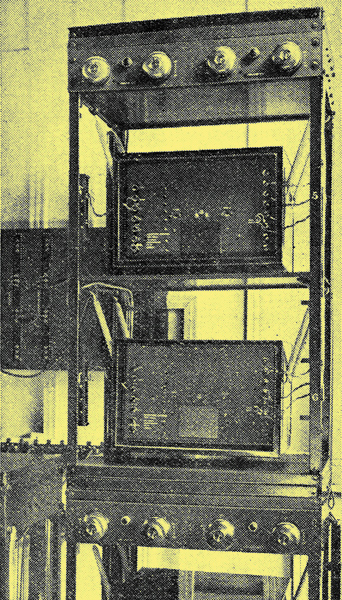
Spring-suspended microphone amplifiers.
The microphones and recording amplifiers for all the studios are assembled together in a room on the first floor, and by an elaborate system of screened permanent wiring any desired combination of microphones, amplifiers and recorders can be arranged. Thus, in the case of an important broadcast several master waxes can be cut simultaneously. HT current for the amplifiers is obtained ready smoothed from the adjacent rectifier room in which there are five separate channels employing mercury vapour rectifier valves. There is also a battery room from which filament heating current is obtained. As in the case of the microphones and recording machines, the whole of the amplifying equipment has been developed and built by the HMV Research Department.
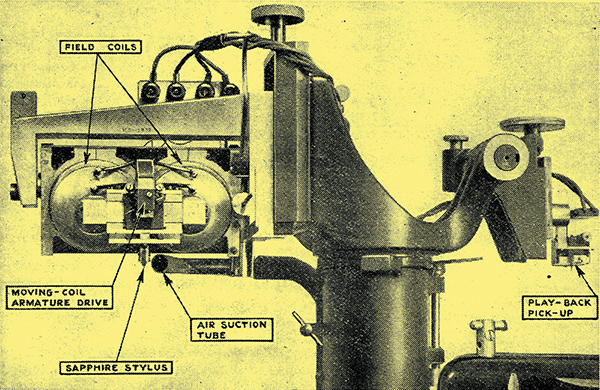
A close-up of the moving-coil recorder showing play-back pick-up.
The sapphire cutting points are all prepared, on the premises, from the rough stone, and the equipment includes a powerful projection microscope by means of which the cutting angles can be accurately measured.
The editing of records such as the Aldershot Tattoo is carried out in the Transfer Room, where excerpts from a series of master records can be combined to give a playing time of the required length. The Acoustics Section is provided with a research laboratory, and a special room is set aside for recording from Broadcasting House, to which a permanent private line is connected.
The air-conditioning plant occupies most of the basement, and is important not only in keeping the building at the temperature required by the waxes, but also to eliminate variations in the humidity of the sound-absorbing material in the walls of the studios.
In conclusion, the skill of those responsible for the disposition of microphones and studio technique in general should not be overlooked. The modern record is the result of a happy combination of art and science.
|